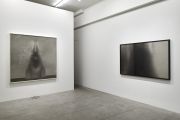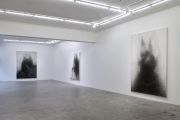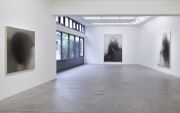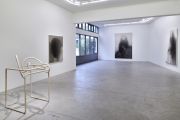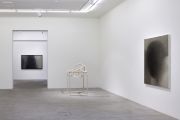Shao Fan
The Ink of Yu Han
May 20 - July 17, 2021
PRESS RELEASE – ENGLISH
Galerie Urs Meile is proud to announce the second exhibition The Ink of Yu Han in Lucerne, by the Chinese artist Shao Fan (*1964), who lives and works in Beijing, China. Following his recent solo exhibition Between Truth and Illusion at Het Noordbrabants Museum in the Netherlands in 2020 and his last show Recent Works in our gallery in Beijing in 2018, this solo show presents Shao Fan’s ink paintings in Europe for the first time, showcasing the artist’s progressive development in ink and how the art of calligraphy can translate into sculpture.
Shao Fan holds a unique position in contemporary art because he weaves the artistic and cultural traditions of China with the contemporary vernacular of Western art. Since his childhood, he was trained by his parents in painting and by his grandmother in calligraphy. In China, calligraphy is the essence of traditional painting, and calligraphic elements continue to be found in many of Shao Fan’s creations. In addition to painting, he has also been recognized for his sculptures, such as Afternoon Nap (2019, old elm wood, 142.5 x 83 x 95 cm), which merges art and design. Calligraphic writing is the starting point for this artwork. Shao Fan explains that the brushstrokes, as well as writing, are the root of culture and are antithetic to modern technology.1
Shao Fan stems from a family of literati, which refers to a social class of scholars accomplished in the connoisseurship in the arts. To honor the spirits of the past and following the literati tradition, when it was common to name oneself during certain artistic phases, Shao Fan adopted the name Yu Han. Hence the exhibition title The Ink of Yu Han closely attributes to the artist’s painting progress, in which he turns away from a rather expressive, wild ductus and takes up constant, quieter brushstrokes.
Comparing works like Rabbit Portrait - Wuxu 2 (2018, ink on silk, 300 x 175 cm) or Black Portrait No. 5 (2018, ink on rice paper, 150 x 120 cm) with his newest work In the Name of Rabbit 202 (2020, ink on rice paper, 113 x 174 cm) lay bare how the artist has changed his brush movements in the past year. While Shao Fan used to explore with longer, more expressive brushstrokes, he started adopting finer, shorter lines. Though all works depict infinite layers of brushmarks of tonal gradations of ink drawn on top of each other, another intensity—like river stems flowing into the sea—accumulates in In the Name of Rabbit 202 (2020).
Also, the subject grows more abstract, zooming into the snout of the hare and thus creating a rather bundled intensity. In contrast, Old Ape on the Rock (2016, ink on rice paper, 300 x 200 cm), Shao Fan’s first successful artwork realized in this monumental size, depicts a fusion of monkey and man. His bony hand and feet allude to a persona of old age and wisdom. Through his peaceful smile and transcendent gaze, he emanates a much more direct, but also hidden intensity.
Shao Fan’s artworks intrigue, not only because of the largescale but foremost because each subject seems to float in a timeless space. Through committed patience, countless layers of ink hues and brushstrokes varied in thickness and tone reveal themselves, portraying perfectly centered, somewhat static protagonists that resemble more monumental old stones than vital animals. It is this scrupulous symbiosis between ink and rice paper that forms this mesmerizing effect. Each creation begins with unmeasurable appreciation dedicated to the painting instruments and its handmade paper because it is precisely this unseen interdependence that results in a unique harmony; pulling the viewer into a transcendent sphere.
It is the negation of light sources, central perspective, or spatial references that allows for the protagonists to float quietly in space. However, an ambiguity unfolds because the scenery seems both flat and deep. Shao Fan emphasizes: “When I look to the future, it has already dwindled into the past. The here-and-now exist at the most insubstantial level; the future and the past both lie in the same direction.”2
Another visual element appears in Rabbit Shadow (2018, ink on rice paper, 240 x 160 cm), where the hare is drawn sketchier and elaborates on the element of darkness. The hare seems to shift from darkness into a lighter foreground. Jun’ichiro Tanazaki writes in In Praise of Shadows (1933): “Where it not for shadows, there would be no beauty.”3 Chinese aesthetics opposes the Western idea of brightness because beauty does not emanate from the object itself but lies in the patterns of shadow. Brightness opposes obscurity. While darkness symbolizes the past, embracing our ancestors, it is also when shallow brilliance wears off, that a smoky patina, so to say, beauty grows through temporal continuity.
Shao Fan also translates this concept in his latest work In the Name of Rabbit 121 (2020, ink on rice paper, 175 x 175 cm), portraying a monumental hare, in a sharp and defined ductus, standing on a firm ground whose torso is encircled by constellations. With its huge ears with a slight frontal inclination and bright eyes, the hare invites the viewer to look closely and observe the concept it holds.
Another distinctive element is that the subjects are centered on a vertical axis, relating to the cosmic harmony. In In the Name of Rabbit 121 (2020), this harmony however is intentionally broken by the golden tip of the nose, perfectly centered in the painting’s composition. Herein, the nose equals the polar star. Diagonally top left, the great wagon rises amidst other constellations. The polar star never moves and in Chinese astronomy, it represents the center of the universe, while all other constellations encircle it.
It is noteworthy that the hare, same as the ape, has no grand significance. Instead, it serves as a habitual motif, being portrayed in a human size to meet the viewer on eye level, intending a horizontal relationship. Moreover, the artist suggests the reflection that animals only take as much as they need to live and survive in this world, while humans exploit and destroy in gluttony.
Overall, by valuing repetition, Shao Fan claims, that time is being recycled and goes beyond history. His artistic pursuit aims to portray that contemporaneity is made from what was before, in tune with the circadian rhythm without beginning nor end.
Shao Fan, Zi (Yu Han) was born in 1964 to a family of artists in Beijing and has lived there ever since. He studied painting with his mother and father from a young age. He has held many solo exhibitions and has repeatedly participated in important group exhibitions. Recent solo exhibitions include: Shao Fan: Between Truth and Illusion, Het Noordbrabants Museum ‘s Hertogenbosch, Netherlands (2020); YOU, Ludwig Museum im Deutschherrenhaus, Koblenz, Germany (2018) and Suzhou Museum, Suzhou, China (2018); Recent Works, Galerie Urs Meile Beijing-Lucerne, Beijing, China (2018); Histoire naturelle, Kunstmuseum Luzern, Lucerne, Switzerland (2018); Big Rabbit +, Galerie Urs Meile Beijing-Lucerne, Beijing, China (2016); Chinese Whispers, Kunstmuseum Bern and Zentrum Paul Klee, Bern, Switzerland (2016); A New Dynasty—Created in China, ARoS Aarhus Art Museum, Aarhus, Denmark (2015); “Secret Signs” Chinese contemporary calligraphy exhibition, Deichtorhallen, Hamburg, Germany (2014); De la Chine aux Arts Décoratifs, Musée des Arts Décoratifs, Paris, France (2014); St. Moritz Art Masters, St. Moritz, Switzerland (2013); Ink Art: Past as Present in Contemporary China, The Metropolitan Museum of Art, New York, USA (2013); Go Figure! Contemporary Chinese Portraiture, National Portrait Gallery, Canberra, Australia (2012); as well as the First Beijing International Design Triennial, National Museum of China, Beijing, China (2011). Numerous museums around the world, such as The Metropolitan Museum of Art in New York City, Peabody Museum of Salem in the United States, National Art Museum of China, Victoria and Albert Museum in England, Hong Kong’s M+ Museum, Fukuoka Art Museum in Japan, Royal Ontario Museum in Canada, Sigg Collection, Erlenmeyer Foundation in Switzerland, among others, have been collecting his works since 1988.
1 Heinz-Norbert Jocks: The Beautiful and the Old, 2014
2 Shao Fan: Appreciation of Oldness, 2012
3 Juni’chiro Tanazaki: In Praise of Shadows, 1977 (1933), p. 30.
PRESS RELEASE – DEUTSCH
Galerie Urs Meile freut sich die zweite Ausstellung The Ink of Yu Han des in Peking lebenden und arbeitenden chinesischen Künstlers Shao Fan (*1964) in Luzern anzukündigen. Nach seiner Einzelausstellung Between Truth and Illusion im Het Noordbrabants Museum in den Niederlanden im Jahr 2020 und seiner letzten Ausstellung Recent Works in unserer Galerie in Peking im Jahr 2018, präsentiert die aktuelle Ausstellung zum ersten Mal in Europa ausschliesslich Tuschemalereien des Künstlers und zeigt seine fortschreitende Entwicklung in der Tuschepraxis und wie er die Kunst der Kalligrafie in Skulptur übersetzt.
Shao Fan nimmt in der zeitgenössischen Kunst eine einzigartige Position ein, weil er die künstlerischen und kulturellen Traditionen Chinas mit der zeitgenössischen Sprache der westlichen Kunst verwebt. Seit seiner Kindheit wurde er von seinen Eltern in der Malerei und von seiner Grossmutter in der Kalligrafie ausgebildet. In China ist die Kalligrafie die Essenz der traditionellen Malerei und kalligrafische Elemente finden sich auch heute noch in vielen von Shao Fans Kreationen. Nebst der Malerei ist er auch bekannt für seine Skulpturen, wie Afternoon Nap (2019, altes Ulmenholz, 142,5 x 83 x 95 cm), die Kunst und Design miteinander verbinden und deren Formen oft in der Kalligrafie wurzeln. Shao Fan erklärt, dass die Pinselstriche, wie auch die Schrift, die Wurzeln von Kultur sind und im Gegensatz zur modernen Technologie stehen.1
Shao Fan entstammt einer sogenannten literati Familie. Der Begriff bezieht sich auf eine soziale Klasse von Gelehrten, die nach Meisterschaft in den Künste streben. Um den Geist der Ahnen zu ehren und in Anlehnung an die Tradition der literati, war es einst üblich, sich in bestimmten künstlerischen Schaffensphasen einen neuen Eigennamen zu geben. Deswegen nahm Shao Fan den Namen Yu Han an. Der Ausstellungstitel The Ink of Yu Han steht in engem Zusammenhang mit der malerischen Entwicklung des Künstlers, in der er sich von einem eher expressiven, wilden Duktus abwendet und einen gleichmässigeren, ruhigeren Pinselstrich annimmt.
Vergleicht man Arbeiten wie Rabbit Portrait - Wuxu 2 (2018, Tusche auf Seide, 300 x 175 cm) oder Black Portrait No. 5 (2018, Tusche auf Reispapier, 150 x 120 cm) mit seiner neuesten Arbeit In the Name of Rabbit 202 (2020, Tusche auf Reispapier, 113 x 174 cm), wird deutlich, wie der Künstler seinen Pinselgestus im letzten Jahr verändert hat. Während Shao Fan zunächst längere, expressivere Pinselstriche setzte, zieht er nun feinere, kürzere Linien. Obwohl alle Arbeiten unendliche Schichten von übereinander gezeichneten Pinselstrichen aus abgestuften Tönungen in Tinte zeigen, öffnet sich in In the Name of Rabbit 202 (2020) eine andere Intensität—wie Flussdeltas, die ins Meer fliessen.
Auch das Motiv wird abstrakter, zoomt in die Schnauze des Hasen hinein und erzeugt so eine eher gebündelte Intensität. Im Gegensatz dazu steht Old Ape on the Rock (2016, Tusche auf Reispapier, 300 x 200 cm). Das Bild war Shao Fans erstes erfolgreich realisiertes Tuschewerk in dieser monumentalen Grösse. Die Figur ist eine Verschmelzung von Affe und Mensch, wobei die knochigen Hände und Füsse auf eine Persona hohen Alters und voller Weisheit hinweisen. Durch sein friedliches Lächeln und seinen transzendenten Blick strahlt er eine direkte, aber auch geheimnisvolle Intensität aus.
Shao Fans Kunstwerke faszinieren nicht nur wegen ihres Grossformats, sondern vor allem, weil jedes Motiv in einer zeit- und raumlosen Dimension zu schweben scheint. Bei geduldiger Betrachtung offenbaren sich unzählige Schichten von Tusche und Pinselstrichen, die in Breite und Tönung variieren und perfekt zentrierte, etwas statische Protagonisten porträtieren, die eher monumentalen alten Steinen als lebendigen Tieren ähneln. Es ist die Symbiose zwischen Tusche und der variierenden Textur des Reispapiers, die diesen hypnotisierenden Effekt erzeugt. Jede Kreation beginnt mit einer unermesslichen Hingabe und Wertschätzung, die den Malmitteln und dem handgeschöpften Papier gewidmet ist. Denn diese unsichtbare Interdependenz führt zu einer einzigartigen Harmonie, welche den Betrachter in eine transzendente Sphäre zieht.
Es ist die Negation von Lichtquellen, Zentralperspektive oder räumlichen Bezügen, die es den Protagonisten ermöglicht, ruhig im Raum zu schweben. Dennoch entfaltet sich eine Ambiguität im Werk, weil die Szenerie sowohl flach als auch tief erscheint. Shao Fan betont: “Wenn ich in die Zukunft blicke, schwindet diese bereits in die Vergangenheit. Das Hier und Jetzt existiert auf der substanzlosesten Ebene; die Zukunft und die Vergangenheit liegen beide in der gleichen Richtung.”2
Ein weiteres visuelles Element erscheint in Rabbit Shadow (2018, Tusche auf Reispapier, 240 x 160 cm), wo der Hase skizzenhafter gezeichnet ist und das Element der Dunkelheit herausarbeitet. Der Hase bewegt sich aus der Dunkelheit in einen helleren Vordergrund. Jun’ichiro Tanazaki schreibt in In Praise of Shadows (1933): “Gäbe es keine Schatten, gäbe es keine Schönheit.”3 Die chinesische Ästhetik wendet sich gegen die westliche Vorstellung von Helligkeit, weil die Schönheit nicht vom Objekt selbst ausgeht, sondern erst durch die Schatten entsteht. Helligkeit steht im Gegensatz zur Dunkelheit. Während die Dunkelheit die Vergangenheit symbolisiert, die auch unsere Vorfahren umschliesst, wächst erst dank zeitlicher Kontinuität eine rauchige Patina, sozusagen die Schönheit, wenn der seichte Glanz nachlässt.
Shao Fan übersetzt dieses Konzept auch in seinem neuesten Werk In the Name of Rabbit 121 (2020, Tusche auf Reispapier, 175 x 175 cm), das einen monumentalen Hasen zeigt, der in einem scharfen und definierten Duktus auf festem Grund steht und dessen Torso von Sternbildern umringt ist. Mit seinen riesigen, leicht nach vorne geneigten Ohren und den leuchtenden Augen lädt der Hase den Betrachter ein, genau hinzuschauen.
Ein charakteristisches Element ist, dass der Hase auf einer vertikalen Achse zentriert ist, was sich auf die kosmische Harmonie bezieht. In In the Name of Rabbit 121 (2020) wird diese Harmonie jedoch absichtlich durch die goldene Nasenspitze gebrochen, die sich kompositorisch in der exakten Mitte befindet. Hier ist die Nase gleichbedeutend mit dem Polarstern. Schräg links erhebt sich der grosse Wagen inmitten anderer Sternbilder. Der Polarstern bewegt sich nie und stellt in der chinesischen Astronomie das Zentrum des Universums dar, während alle anderen Sternbilder ihn umkreisen.
Es ist bemerkenswert, dass der Hase, ebenso wie der Affe, keine grosse Bedeutung trägt für Shao Fan. Stattdessen dient er als gewöhnliches Motiv. Er wird in menschlicher Grösse dargestellt, um dem Betrachter auf Augenhöhe zu begegnen und fordert somit eine horizontale Beziehung. Darüber hinaus legt der Künstler die Überlegung nahe, dass Tiere nur so viel nehmen, wie sie zum Leben und Überleben in dieser Welt brauchen, während die Menschen in Unersättlichkeit ausbeuten und zerstören.
Allem voran durch die Wertschätzung von Wiederholungen, behauptet Shao Fan, dass die Zeit recycelt wird und über die Geschichte hinausgeht. Sein künstlerisches Streben zielt darauf ab, darzustellen, dass Zeit aus dem besteht was vorher war und in Einklang mit dem immerwährenden Rhythmus ohne Anfang und Ende fortbesteht.
Shao Fan, Zi (Yu Han) wurde 1964 in einer Künstlerfamilie in Peking geboren und lebt seither dort. Er studierte von klein auf Malerei bei seiner Mutter und seinem Vater. Er hatte bereits viele Einzelausstellungen und hat wiederholt an wichtigen Gruppenausstellungen teilgenommen. Zu seinen jüngsten Einzelausstellungen gehören: Shao Fan: Between Truth and Illusion, Het Noordbrabants Museum ‘s Hertogenbosch, Niederlande (2020); YOU, Ludwig Museum im Deutschherrenhaus, Koblenz, Deutschland (2018) und Suzhou Museum, Suzhou, China (2018); Recent Works, Galerie Urs Meile Beijing-Lucerne, Beijing, China (2018); Histoire naturelle, Kunstmuseum Luzern, Luzern, Schweiz (2018); Big Rabbit +, Galerie Urs Meile Beijing-Lucerne, Beijing, China (2016); Chinese Whispers, Kunstmuseum Bern und Zentrum Paul Klee, Bern, Schweiz (2016); A New Dynasty—Created in China, ARoS Aarhus Art Museum, Aarhus, Dänemark (2015); “Secret Signs” Chinese contemporary calligraphy exhibition, Deichtorhallen, Hamburg, Deutschland (2014); De la Chine aux Arts Décoratifs, Musée des Arts Décoratifs, Paris, Frankreich (2014); St. Moritz Art Masters, St. Moritz, Schweiz (2013); Ink Art: Past as Present in Contemporary China, The Metropolitan Museum of Art, New York, USA (2013); Go Figure! Contemporary Chinese Portraiture, National Portrait Gallery, Canberra, Australien (2012); sowie die First Beijing International Design Triennial, National Museum of China, Beijing, China (2011). Zahlreiche Museen auf der ganzen Welt, wie das Metropolitan Museum of Art in New York City, das Peabody Museum of Salem in den USA, das National Art Museum of China, das Victoria and Albert Museum in England, das M+ Museum in Hongkong, das Fukuoka Art Museum in Japan, das Royal Ontario Museum in Kanada, die Sigg Collection, die Erlenmeyer-Stiftung in der Schweiz, uvm., sammeln seine Werke seit 1988.
1 Heinz-Norbert Jocks: The Beautiful and the Old, 2014
2 Shao Fan: Appreciation of Oldness, 2012
3 Juni’chiro Tanazaki: In Praise of Shadows, 1977 (1933), p.30
download
opening
May 20, Thursday; 5:30-7:30 pm

